As an Amazon Associate, I earn from qualifying purchases.
An easy step-by-step tutorial on Canning Peaches. This recipe for how to preserve peaches is perfect for beginners and experienced canners alike. Instructions include low-sugar and no-sugar options.

Peaches are one of the easiest fruits to can. Sure, you have to peel them, but that can be accomplished fairly easily.
Even better, I’m going to teach you how to make canned peaches in light syrup, so you can actually taste the fruit and not just sugar. Need no-added-sugar options? We’ve got those too!
And if you decided that peach preservation is just not for you, check out our Peach Freezer Jam, Peach Preserves, Homemade Peach Ice Cream, Peach Syrup, Drying Peaches, Peach Compote, tutorial on How to Freeze Peaches, and our Ginger Beer Mocktail. All use delicious fresh peaches without canning.
Canning Equipment List
Check out this in-depth post for a complete list of canning supplies.
- Peaches! You’ll need about 17 lbs per 7 quarts. You can always can fewer jars if you only have a handful of peaches.
- At least two large bowls. You can never have enough bowls when canning.
- A large pot of water for blanching the fruit and a medium pot for syrup
- Canner: water bath canner, a pressure canner (which can double as a water bath canner), or even a huge stockpot with a rack in the bottom.
- Canning tongs/jar lifter
- Jars – quarts or pints.
- New, clean canning lids
- Canning rings
- Wide mouth funnel
- Ice
- Sugar, honey, or juice
- lemon juice or citric acid
- Paring knife
- Cutting board
- Slotted spoon
- Ladle
- Butter knife or plastic chopstick
- Comfortable shoes. Don’t do this barefoot. Your back will hate you.
- Clean washcloths and at least one thick clean towel.
How to Can Peaches
*I’ll walk you through it here with some photos and tips, and you’ll also find a printable recipe card at the bottom of the post with exact measurements, etc. You can also click “jump to recipe” to skip down.
CANNING PREP
Prepare your water bath canner by filling it with water. You need to have enough water to cover the jars by 1 inch once the water is boiling.
Set the canner on the stove. Turn the burner to high. Once it reaches a boil, reduce it to a simmer. You want to keep the water hot so that everything is ready when the fruit is.
Wash and clean your jars. You’ll want to keep them warm to avoid having them crack when placed in the canner. You can fill them with hot water, or place them on a tray in the oven at 170˚F.
Wash your lids and set them aside in a clean place. You no longer need to simmer lids in water to keep them sterile. Woot!
Wash your fruit. I just run them under water and rub my hands on them to give the outside a scrub. Use a paring knife and cut the peach around the middle to separate it.

Remove the pit
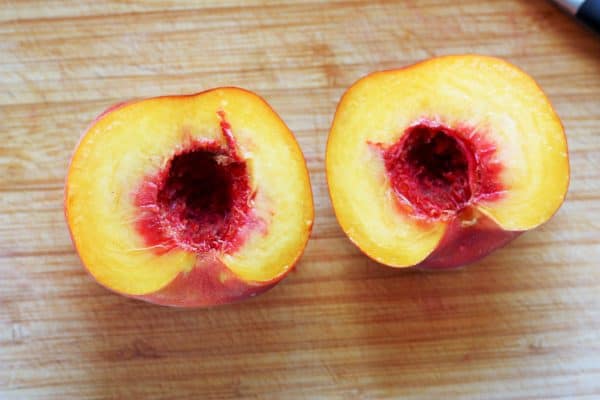
Put the halves in a large bowl of water treated with lemon juice or citric acid.
Blanching Peaches
Add one layer of peaches at a time to a pot of boiling water for about 60 seconds. Once you can see the skin starting to come away from the flesh, it’s time to take them out.
Remove using a slotted spoon and place in an ice bath for 1 minute.
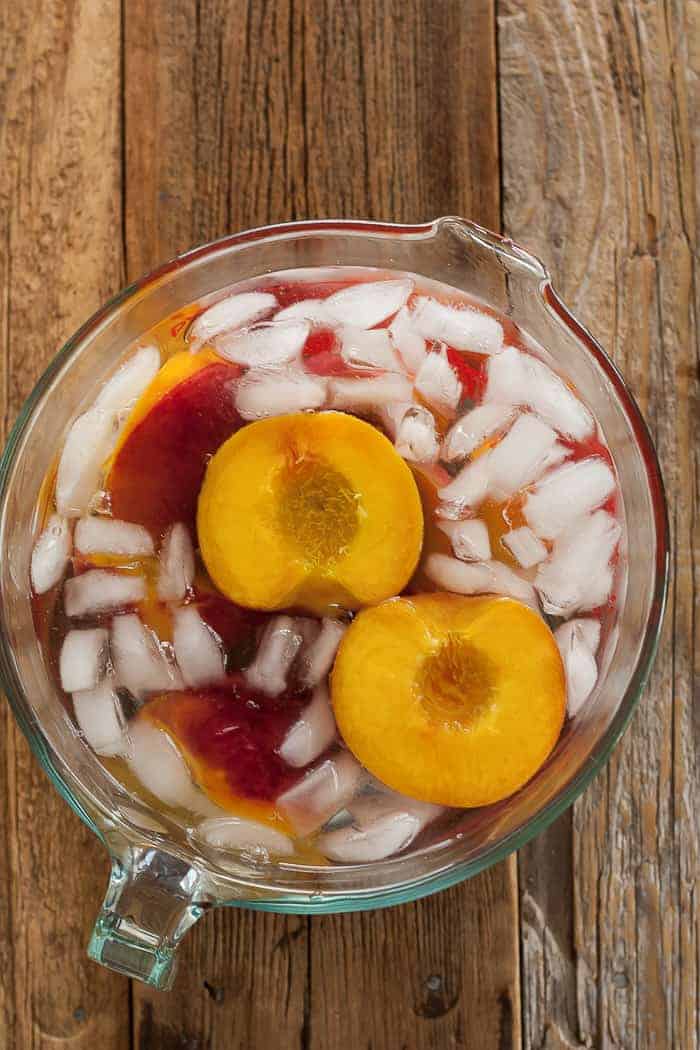
Use the slotted spoon to remove the peaches from the ice bath. Grab one and gently peel the skin back.
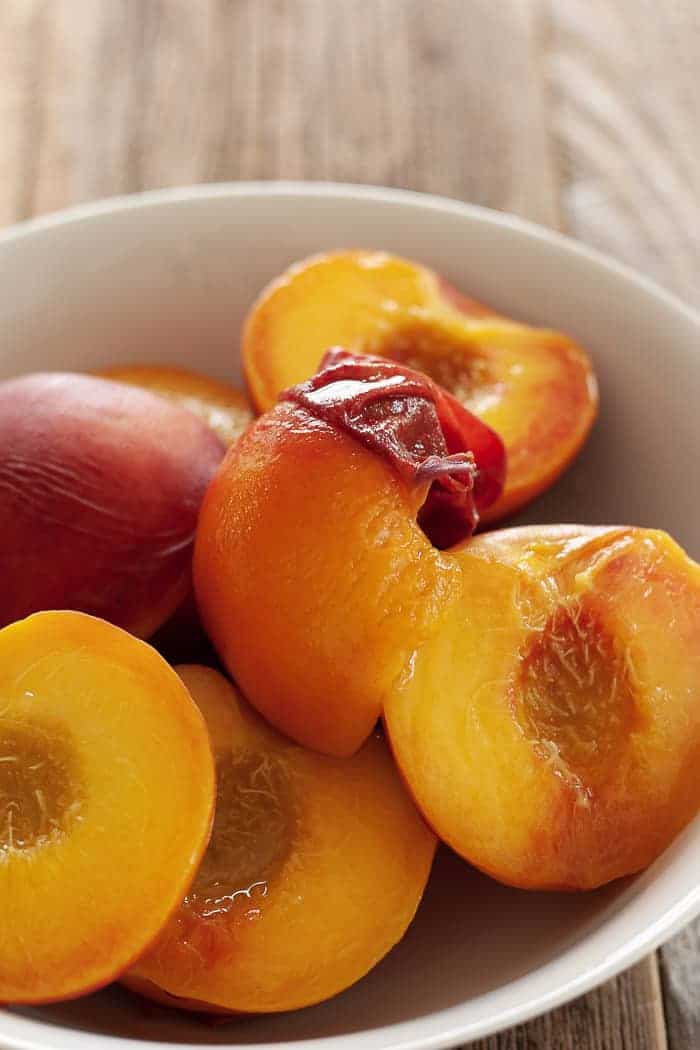
Syrups for Canning Peaches
If you prefer a no-sugar option, peaches can be canned using only water. But if you plan to can your peaches with sweetener, you can use sugar, honey, or fruit juice (apple or white grape). You’ll also want to decide how sweet you want the syrup to be.
In a medium-sized pot, combine your sugar/honey/or juice, and water to create the syrup. See the cheatsheet below as a guideline for making syrup:
Syrups for Canning
| Syrups for Canning | ||||
| Type of Syrup | Sweetener | Amount of Sweetener | Water | Yield |
| Very light | Sugar | 1 cup | 6 cups | 5 3/4 cups |
| Light | Sugar | 2 1/4 cups | 5 1/4 cups | 6 1/2 cups |
| Medium | Sugar | 3 1/4 cups | 5 cups | 7 cups |
| Heavy | Sugar | 4 cups | 5 cups | 7 cups |
| Honey | Honey | 1 cup | 4 cups | 4 1/4 cups |
| Juice | Apple or white juice concentrate | 1 1/2 cups | 4 1/2 cups | 6 cups |
| *Source: National Center For Home Food Preservation | ||||
Pro tip: if you plan to process multiple batches of peaches in a day, make the syrup and transfer it to a slower cooker set to “high”. This will keep the syrup hot while freeing up space on your stove.
Raw Pack For Canning Peaches
Raw packing simply means placing the peeled peaches in the jars without pre-cooking them, filling the jars with hot syrup, and processing them in the canner.
If you are canning your peaches without additional added sugar (sugar, honey, fruit juice), you must hot pack the fruit.
Raw packing is much faster than then a hot packing process, but there are some drawbacks. No matter how well you pack the jars, the density of the fruit will change during their time in the canner.
This often leads to something called “fruit float” in which the peaches will float to the top of the jar, leaving all syrup on the bottom. There is nothing wrong with fruit float as long as your jars are still sealed.
You’ll find this when you’re canning pears, canning apricots, and canning whole tomatoes as well.
To raw pack the peaches, add the fruit cavity-side down (where the pit was) to your sanitized and warm canning jars. This is easiest done with a fork. Repeat with other peach halves until you have filled the jar. Then, ladle hot syrup over the top of the peaches. Pro tip: depending on the size of the fruit, each quart will fit about 3-3.5 peaches.
Hot Pack For Canning Peaches
Hot packing involves cooking the peaches briefly in hot syrup before packing the peaches into jars for canning.
You’ll want to boil the peach halves in the canning syrup for about 2 minutes and then add them to your jars, ladling more hot syrup over the top.
The benefits of hot packing are that you typically can fit more fruit per jar, and the near elimination of fruit float.
Canning The Peaches
At this point, return your water in the canner back to a rolling boil.
Using a canning funnel, ladle hot syrup into the jars, leaving 1/2 inch headspace. Headspace is the distance between the top of the food and the top of the jar. You may need to use a spoon to gently smoosh down the fruit a bit.
Using a long utensil (I prefer a plastic chopstick), remove all the air bubbles from the jar. Clean the rim of the jar very well with a hot damp rag. Place a clean lid on the jar. Add a ring, and tighten to fingertip tight.
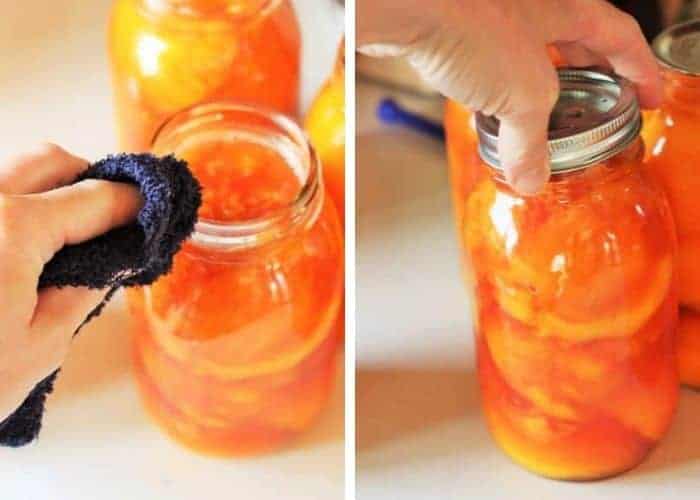
Using canning tongs, carefully place your jars in the canner. Put the lid on. Processing times will vary based on altitude. See the chart below.
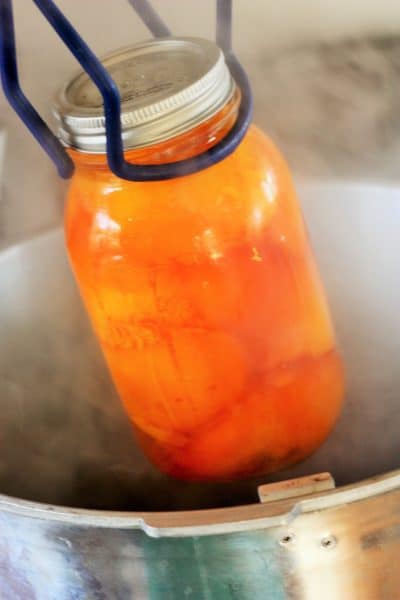
PROCESSING TIME FOR Canning Peaches
Pro tip: the water must return to a boil in the canner before you can start the timer.
Processing Time for Peaches
| Processing Time for Peaches | |||||
| Process Times at Altitudes of: | |||||
| Style of Pack | Jar Size | 0-1,000 ft | 1,001-3,000 ft | 3,001-6,000 ft | Aove 6,000 ft |
| Hot | Pints | 20 min | 25 min | 30 min | 35 min |
| Quarts | 25 min | 30 min | 35 min | 40 min | |
| Raw | Pints | 25 min | 30 min | 35 min | 40 min |
| Quarts | 30 min | 35 min | 40 min | 45 min | |
| *Source: National Center For Home Food Preservation | |||||
Once the jars have been processed for the appropriate amount of time, remove the canner from the burner, wearing oven mitts carefully take off the lid of the canner, and allow it to sit for 5 minutes. Pro tip: I tend to just slide the canner into the middle of my stove, as it weighs a ton.
Carefully remove the jars with canning tongs, and place them on a thick towel in a place where they can be undisturbed for 12 hours.
The lids will likely start to pop within 20-30 minutes of being removed from the water. That popping sound is music to your ears, as it tells you that everything has been sealed. It’s a reward for all your work!
After the jars have rested for about 12 hours, press down in the middle of each lid. If it “gives” at all, the jar didn’t seal. Either enjoy it that day, put it in the fridge, or reprocess it.
Pressure Canning Peaches
If you prefer to pressure can your peaches, follow the prep and packing process above and the canning process below.
Add 3 quarts of water to your pressure canner and put it on a burner set to high. Make sure there is a canning rack in the bottom of the canner.
Using canning tongs, gently place the jars in the canner. Lock the lid. Soon, steam will start coming through the vent pipe (I call it the steam chimney).
Allow the steam to pass through for about 10 minutes. Then put the pressure regulator (I call it the chimney cap) on top. (see the 4 photo grid below for a visual of this process step by step)
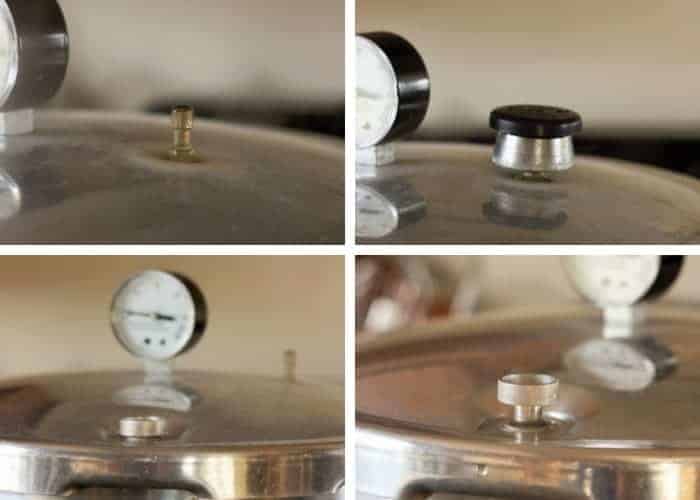
Pretty soon, the air vent will pop up. That is a sign that you’re starting to build pressure inside the canner (get excited. This is happening!). Processing times will vary based on altitude. See the charts below.
Pressure Canning Peaches in a Dial-Gauge Pressure Canner
| Canner Pressure (PSI) at Altitudes of | ||||||
| Style of Pack | Jar Size | Processing Time | 0-2,000 ft | 2,001-4,000 ft | 4,001-6,000 ft | 6,001-8,000 ft |
| Hot or Raw | Pints or Quarts | 10 min | 6 lbs | 7 lbs | 8 lbs | 9 lbs |
| *Source: National Center For Home Food Preservation | ||||||
Processing Time for Peaches in a Weighted-Gauge Pressure Canner
| Canner Pressure (PSI) at Altitudes of: | ||||
| Style of Pack | Jar Size | Processing Time | 0-1,000 ft | Above 1,001 ft |
| Hot or Raw | Pints or Quarts | 10 min | 5 lb | 10 lb |
| *Source: National Center For Home Food Preservation | ||||
When the dial gauge reaches the appropriate PSI, reduce the burner temp to medium, and start your timer. The pressure must stay at the PSA or (a little bit) above for the duration of the cooking time. You’ll likely need to adjust the temp on the burner a few times depending on your stove.
When the time is up, remove the canner from the burner and allow it to sit until you hear a distinctive “click” of the air vent dropping. Remove the pressure regulator and carefully remove the lid of the canner (Pro tip: I always use oven mitts when I take the lid off because the steam is super hot).
Let the jars sit for 5 minutes in the canner with the canner lid off and then lift them out with canning tongs. Pro tip: allowing the jars to sit in the canner with the canner lid off can help reduce the siphoning of liquid in your jars.
Place hot jars on a towel where they can sit undisturbed for 12 hours.
After a few hours, to check for sealing, gently press down in the middle of the lid. If the lid has no give, it’s sealed. If you can press the lid in and it pops a bit, your jars are not sealed.
STORAGE FOR HOME CANNED Peaches
Once the jars have sealed, remove the rings. Label and store sealed jars in a cool (best results are 50-70˚F) dark place for up to 12-18 months.
If you have the space available, do not stack the jars on top of each other more than two jars high.
Frequently Asked Questions
Most varieties will work for canning. You’ll find peaches come in two main types:
Freestone – when cut in half, the peach will separate easily from the pit. These make canning so much easier!
Cling – the peach flesh will “cling” to the pit, making it very challenging to cut them in half. If you use cling peaches for canning, you will likely be canning peach slices instead of peach halves. For help with tackling the task of working with the cling variety, check out this post on How to Cut a Peach.
At this time, the National Center for Home Food Preservation does not recommend you can white peaches. The ph levels vary too much, making them generally unsafe to can. It is recommended you freeze white peaches instead of canning them.
Yes. That being said, sugar is used in canning for flavor, preservation, and color. Sweet food generally tastes better, keeps longer, and the color of the food stays bright and fresh.
Peaches have enough natural sugar and don’t need any sweetener added while canning to be considered safe. But your final product may look a bit different and have a shorter shelf life.
Personally, I walk the line between no sugar and low sugar for canning peaches and canning pears.
Yes, you are able to can peaches with honey.
Please note, if you’re using raw honey, any of the beneficial properties will be killed during the heating process. It’s more affordable to use regular honey for canning.
Yes, you are able to can peaches with fruit juice.
You’ll need 48 oz of juice per 4 pounds of peaches using a hot pack process. Using frozen concentrated apple or white grape juice is a great and easy substitution for refined sugar syrup.
Use one can of thawed concentrate mixed with three cans of water.
They are safe to eat as soon as the jars have cooled!
Unlike a project like Refrigerator Dilly Beans, home-canned peaches don’t need to rest before they’re ready to enjoy. Dig in!
Help! Why Are My Jars Leaking Juice?
If you find that juice has leaked out after they have sealed, you have experienced a common canning issue called siphoning. It happens to the best of us!
Siphoning is typically caused by not allowing the jars to rest in the canner after they have finished processing. In the directions above, you’ll see that I recommend you remove the canner from the burner, remove the lid, and let it sit for 5 minutes.
This is important as it allows the jars time to rest before being allowed to cool on the counter. Doing this process will significantly cut down on siphoning.
If you have siphoning in your jars, follow these steps:
- Check – are the lids still sealed?
- Look – have you lost less than half of the amount of liquid in the jar?
- Examine – does the fruit look fresh with bright colors?
If the answer to the above three steps is “yes!”, then they are safe to eat. If you lost quite a bit of syrup, the uncovered fruit will turn color more quickly. Plan to eat those jars first.
What if my jars don’t seal?
If you’ve correctly processed your fruit, and the lids still didn’t seal, you can reprocess them.
Double-check to make sure there are no:
- Chips in the rim of the jar
- Dried syrup or bits of peach on the rim (anything between the rim and the lid may prevent a seal.
Best practices would involve using brand-new lids for reprocessing. Set aside the old lids to use for dry storage (related: Pantry Essentials for the Home Cook).
If the jars don’t seal on the second attempt, you likely have a bad batch of lids, or your canning process has a step missing. Email me and we’ll try to troubleshoot what is going on.
For unsealed jars, you can place them in the fridge. Eat the fruit within three weeks.
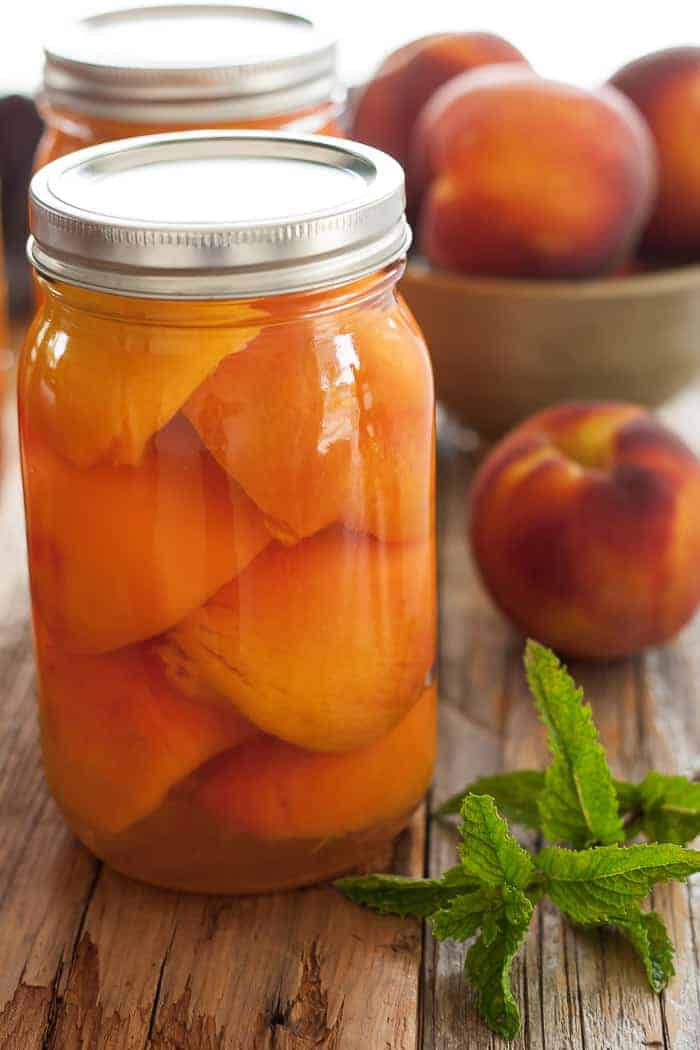
Can I make canned peach slices?
Yes! If you’d prefer to cut your fruit into slices, that is absolutely fine. Think about how you plan to use them after canning. Do you want to eat them as is? If so, halved peaches will be the easiest and fastest way to can them.
If you use them in crisps/crumbles, other desserts, or yogurt (related: Easy Instant Pot Yogurt) slices make a lot of sense!
Pro tip: with canning peach slices, you’ll need to put a bit more effort into removing bubbles from the jars. There will be more opportunities for “pockets” to occur in the jars, and those bubbles need to be removed for safety.
More canning recipes you’ll love:
Check out my entire category of Canning recipes for more ideas and inspiration.
Canning Peaches {How to Can Peaches}
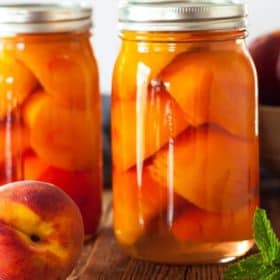
Equipment
Ingredients
- 17 lbs peaches
- 1/4 cup lemon juice
- 6 cups water {+more for the canner}
- 1 1/2 cups sugar
- ice
Instructions
Canning Prep
- Prepare your water bath canner by filling it with water. You just need to have enough water to cover the jars by 1 inch once the water is boiling.
- Set the canner on the stove. Turn the burner to high. Once it reaches a boil, reduce it to simmer. You want to keep the water hot so that everything is ready when the peaches are.
- Wash and sanitize your jars. You’ll want to keep them warm to avoid having them crack when placed in the canner. You can fill them with hot water, or place them on a tray in the oven at 170F.
- Wash your lids and set aside in clean place.
- Use a paring knife and cut the peach around the middle to separate. Remove the pit. Put the halves in a large bowl of water treated with lemon juice (~1/4 cup) or citric acid (1 tbsp).17 lbs peaches, 1/4 cup lemon juice
Blanching Peaches
- Fill a large mixing bowl with ice water. Set aside.ice
- Add one layer of peaches at a time to a pot of boiling water for about 60 seconds.
- Remove using a slotted spoon and place in the ice water for 1 minute.
- Use the slotted spoon to remove the peach halves from the ice bath. Grab one of the peaches and gently peel the skin back.
Canning Peaches
- Combine water and sugar in a medium saucepan. Bring to a low boil and fully dissolve the sugar. See the chart in the post above for different levels of syrup.6 cups water, 1 1/2 cups sugar
- (Hot Pack Method) Once the syrup is boiling, add the peach halves one layer at a time (a canning term that means don’t totally fill the pot) and heat for 2 minutes.
- (Hot pack option) Using a fork and canning funnel, grab the now softened peaches, add the peach halves, one at a time, and put them cavity-side (where the pit was) down in the canning jar.
- (Hot pack option) Repeat with other peach halves until you have filled the jar. Pro tip: depending on the size of the peaches, each quart will fit about 3-3.5 peaches.
- (Hot pack option) Using a canning funnel, carefully ladle hot syrup into the jars, leaving 1/2 inch of headspace.
- (Raw pack option) Using a fork and canning funnel, place peaches cavity-side down in the canning jar.
- (Raw Pack Option) Using a canning funnel and a ladle, fill each jar with hot syrup or water, leaving 1/2 inch of headspace. Headspace is the distance between the top of the food and the top of the jar.
- At this point, return your water in the canner back to a rolling boil.
- Using a long utensil (I prefer a plastic chopstick), remove all the air bubbles from the jar.
- Clean the rim of the jar very well with a hot damp rag.
- Place a clean lid on the jar. Add a ring, and tighten to fingertip tight.
- Using canning tongs, gently place your jars in the canner. Put the lid on, and set your timer. Pro tip: the water must return to a boil in the canner before you can start the timer.
- Process HOT PACK pints and quarts based on the elevation guide below:*0-1,000 ft – Pints =20 min Quarts =25 min*1,001-3,000 ft – Pints =25 min Quarts =30 min*3,001-6,000 ft – Pints =30 min Quarts =35 min*6,000 ft+ – Pints =35 min Quarts =40 min
- Process RAW PACK pints and quarts based on the elevation guide below:*0-1,000 ft – Pints =25 min Quarts =30 min*1,001-3,000 ft – Pints =30 min Quarts =35 min*3,001-6,000 ft – Pints =35 min Quarts =40 min6,000 ft+ – Pints =40 min Quarts =45 min
- Once the peaches have processed for the appropriate amount of time, remove the canner from the burner, and carefully remove the lid of the canner (Pro tip: use oven mitts to take the lid off because the steam is super hot).
- Using canning tongs, carefully remove the jars, and place them on a thick towel in a place where they can be undisturbed for 12 hours.
- After the jars have rested for about 12 hours, press down in the middle of each lid. If it "gives" at all, the jar didn't seal. Either enjoy it that day, put it in the fridge, or reprocess it.
Notes
- If you’re planning to can multiple batches of peaches all at once, I use my crockpot to create and keep the syrup hot. It frees up space on the stove.
- Once the jars have sealed, remove the rings. Label and store sealed jars in a cool (best results are 50-70˚F) dark place for up to 12-18 months.
Nutrition
Nutrition information is automatically calculated, so should only be used as an approximation.

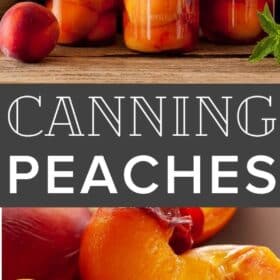
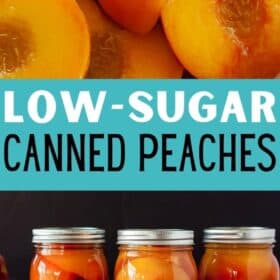
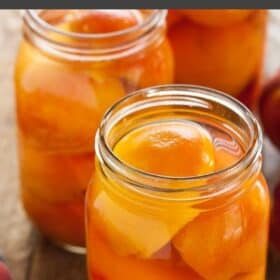
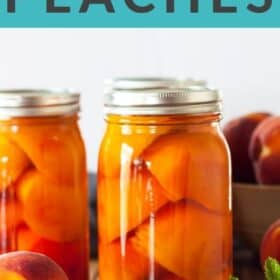
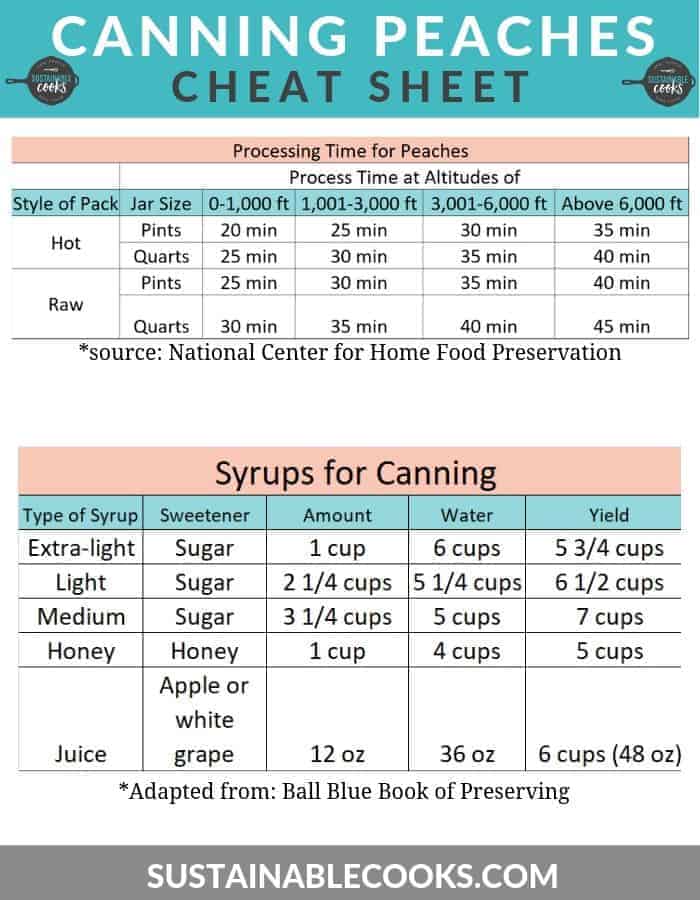
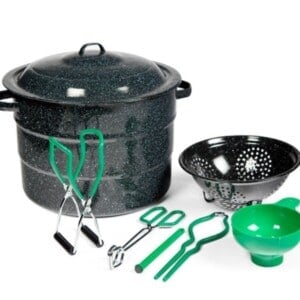
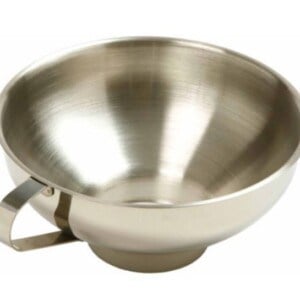
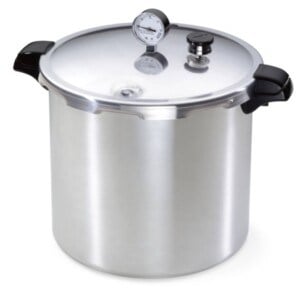
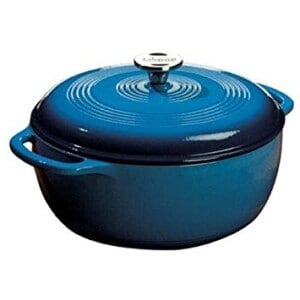
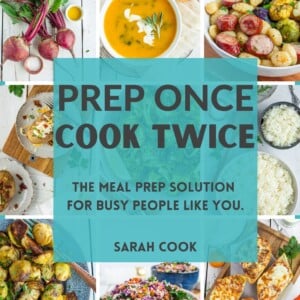
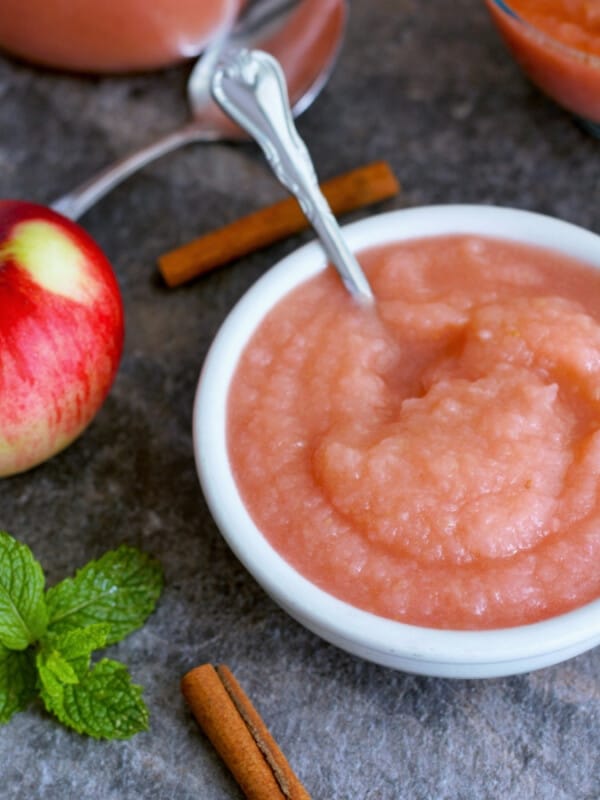

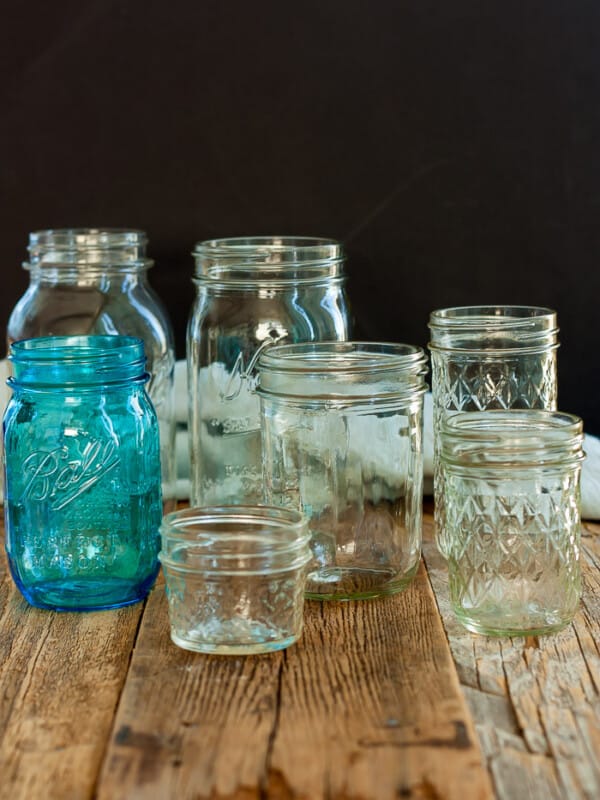
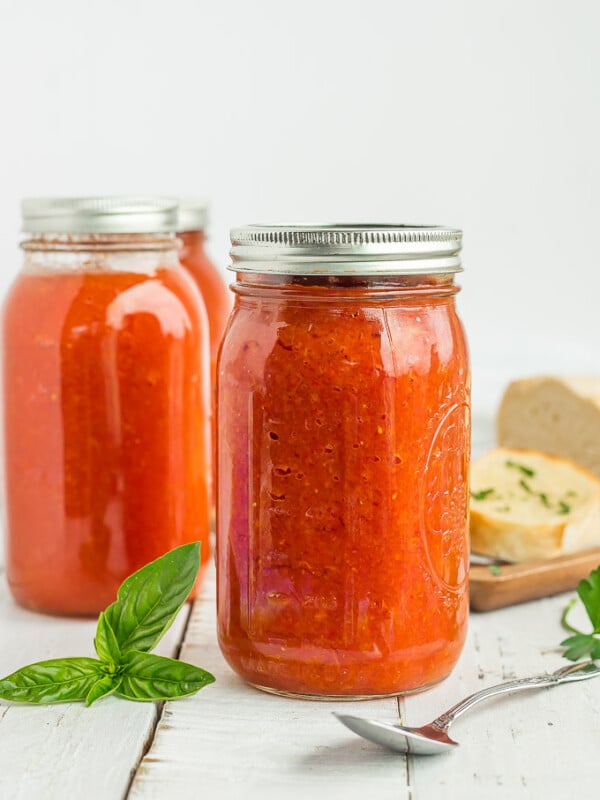
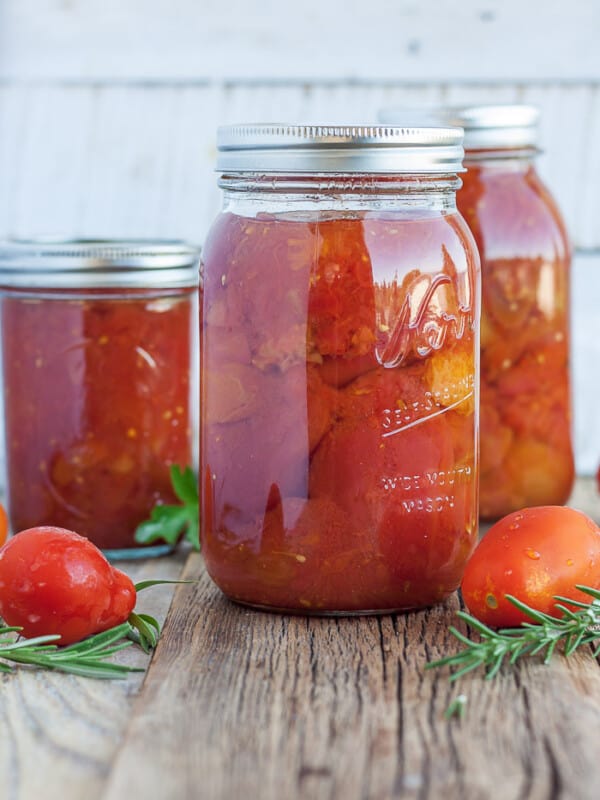
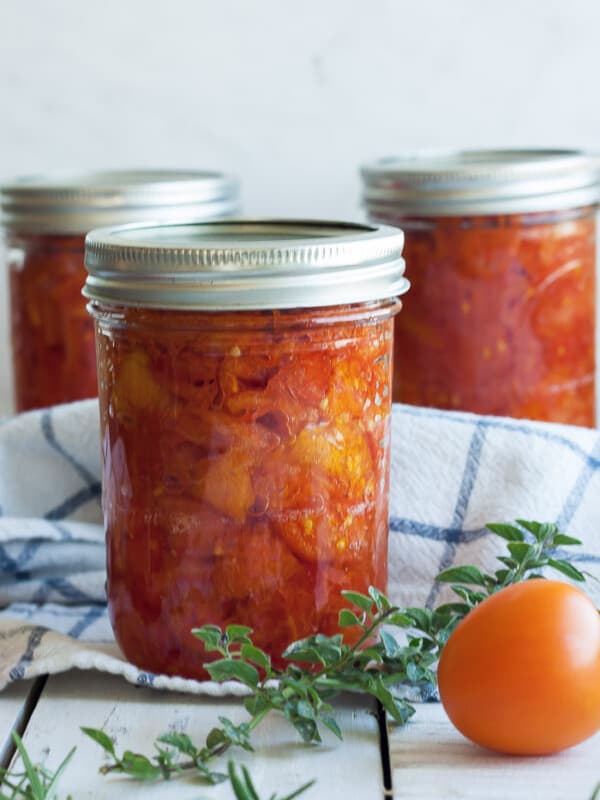






I tried canning peaches for the first time using this recipe. I must say they are simply amazing! I am canning more today
Katy, congrats on your first peach canning experience! I’m honored that I was able to help in any way.
Do you use your water bath canner on your flat top stove? I was looking into buying one but we have a glass flat top stove and the description says not to use on there. Thanks for your input and all of you’re exiles!
It depends on which kind of flat stovetop you have. I got induction once we remodeled our kitchen and my canner does NOT work on it. My dad lives with us and has his own stove in an inlaw style apartment. I use his stove now when I am canning.
I used to use my canner on our old glass top stove and it was fine. But it was also a very cheap stove and I’d be nervous about breaking a good one. You could get a standalone electric plug-in burner for your canner. I have also seen people use a burner on their BBQ for canners.
Thanks for your quick response! I dug around more on the internet and found a water bath canner that is made to use on glass stove tops. Also, sorry about my typo – I love all your recipes – not exiles! 🤦♂️😂
Ha, no worries!!
Followed your recipe to a “T” and they turned out amazing! Thankful for your step by step detailed instructions for this newbie canner. ❤️🍑 thank you for making it super easy for me.
Melissa, congrats on your first batch of peaches!!! I’m so glad I could help in any way. Think of me this winter when you’re enjoying them. 😊
So I tried canning peaches today and I’ve messes up. I got lost and didn’t hot pack the fruit before canning and putting the fruit in the jars. They have made their round in the canner and the jars are popping. Will these still be usable? I used fruit juice. Should I just throw them all out?
Hot packing is not required – it is just one of two methods. It sounds like you chose the raw packing method which is perfectly safe.
Test the lids in a few hours. If they’re sealed, they’re safe.
Thank you for this recipe! For doing hot pack, and utilizing the pro tip of making they syrup in the crock pot, how do you get it to boil for 2 minutes?
Thank you!
I either transfer syrup from my crockpot to a smaller pot on the stove to heat it up, or leave the peaches in the syrup a little bit longer in the crockpot.
Hot packing is just meant to heat the peaches. Peaches don’t need to be fully boiling in the syrup to be safe. The boiling the jars in the canner is what makes the canning process safe.
Thanks for a great article. Love the pro tips!
Question – Is it possible to use granulated maple sugar or coconut sugar instead of regular white sugar?
Yes, it would absolutely work! The flavor would be a bit different but still delicious.
Hi!
In the hot pack method, you stated to boil the peaches in the syrup for 2 minutes. Does that mean to wait until the water starts boiling again? Or time if for two minutes once the peaches are put in the boiling syrup? Sorry for the specific question, I just don’t want to overcook them and make them mushy! Thanks!
Great question!
You can start the timer as soon as you add them to the syrup. With hot packing, the cooking process is only meant to heat the peaches, not sterilize them. You can get a bit more “squishy” with that part of the cooking process vs. when they’re actually in the jars and in the canner.
Hello! I’m looking at this recipe and it sounds good. I want to try canning peaches but I have Georgia peaches. I don’t know if they’re cling or freestone. But they’re super juicy and sweet. When canning can I quarter the peaches or do they have to be in halves? Is there a way to do this without so much sugar?
Hi Terrie, Georgia peaches are more of a marketing thing than a type of peach. I live outside of Seattle so that’s like me saying “Washington apples” even though we grow and sell hundreds of varieties.
If you’re buying peaches from a local farmer, ask if they are cling or freestone; they will absolutely be the expert in which variety they have. You are able to can halves or quarters safely.
As to the sugar, I really encourage you to read the body of the post. I know it’s super long but that is because it’s packed with tons of info and variation (like no sugar vs. heavy sugar) and I don’t want you to miss any important info. It will make the process easier if you have all the information before you get started.
Yes, you are able to can without sugar or even super-low sugar. Within the post there is a chart on how to make super-light all the way to heavy syrup. I tend to can my peaches with about 1 cup of sugar to 6 cups of water, but you can also use fruit juice, honey, or even no sugar at all.
I’m going to copy and paste some of the info from the post below, but I promise there is even more good stuff in the body of the post:
CAN YOU CAN PEACHES WITHOUT SUGAR?
Yes. That being said, sugar is used in canning for flavor, preservation, and color. Sweet food generally tastes better, keeps longer, and the color of the food stays bright and fresh.
Peaches have enough natural sugar and don’t need any sweetener added while canning to be considered safe. But your final product may look a bit different and have a shorter shelf life. Personally, I walk the line between no sugar and low sugar for canning peaches.
CANNING PEACHES WITH HONEY
Please note, if you’re using raw honey, any of the beneficial properties will be killed during the heating process. It’s more affordable to use regular honey for canning.
CANNING WITH FRUIT JUICE
You’ll need 48 oz of juice per 4 pounds of peaches using a hot pack process. Using frozen concentrated apple or white grape juice is a great and easy substitution for refined sugar syrup. Use one can of thawed concentrate mixed with three cans of water.
I actually have peaches delivered from georgia. They’re way better than these nasty things we have in Michigan lol! Getting ready to work with him now. So hopefully it comes out good!
Where the lemon juice used I did not read it in the directions
Hi Jerry, it’s in step 5 of the recipe card. I’ll copy and paste below:
5. Use a paring knife and cut the peach around the middle to separate. Remove the pit. Put the halves in a large bowl of water treated with lemon juice (~1/4 cup) or citric acid (1 tbsp).
Pit cavity down? Wouldn’t that trap air?
Yes, the pit cavity is down. As you release bubbles using a long plastic or metal tool, it agitates the bubbles out.
I have a question do you take the time to scrape out the pink part of your peaches before you can them. They look like you do but you don’t say anything about that. If you don’t does it turn a different color after awhile on the shelf.
Hi Jodie, the “pink” part is more common in cling peaches. When canning, you want to use freestone peaches. Cling peaches are annoying because you cannot easily remove the pit and you have to cut them into slices instead of halves.
The canning peaches (AKA freestone) I can get locally at my farmer’s market don’t really have the pink part around the pit. I’m sure there are strains of freestone peaches out there with pink sections. I would not remove them because they’re totally safe to eat. And that’s too much work for me. 🙂